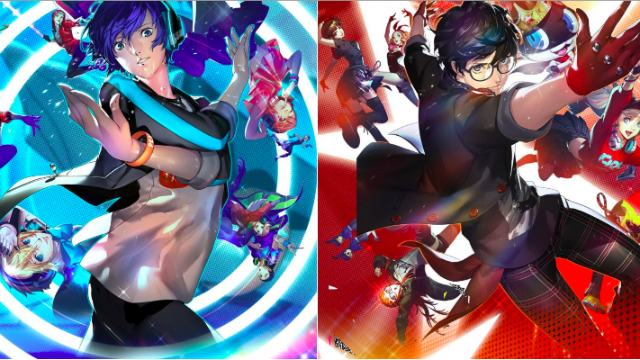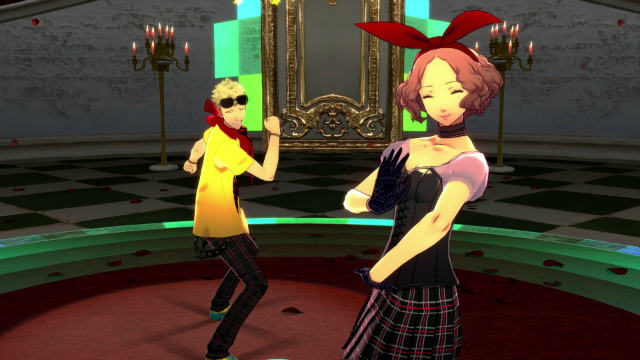The Persona series is dripping with style, and nothing sets that off like the amazing soundtracks included in the games. It’s not hard to get songs like Persona 3‘s Burn My Dread, and Persona 5‘s Beneath the Mask stuck in your head, and for the last three outings, the score has been absolutely outstanding. It was with great enthusiasm I greeted news of the Persona Dancing: Endless Night Collection‘s development. Not only does this collection bring Persona 4: Dancing All Night (see our review here) to PS4, but it also introduces the new games, Persona 3: Dancing in Moonlight and Persona 5: Dancing in Starlight.
Before I get to the meat of the review, I want to clarify just what the MSRP of the Persona Dancing: Endless Night Collection is. The collection itself is only available on PS4 and costs $99.99. It consists of Persona 3: Dancing in Moonlight, Persona 4: Dancing All Night, and Persona 5: Dancing in Starlight. If you want Persona 3 Dancing or Persona 5 Dancing individually, you’re looking at a $59.99 purchase, and buying the Endless Night Collection is the only way to get Persona 4 Dancing on PS4. Vita owners can buy a collection containing P3D and P5D plus a costume pack for $69.99 or buy them individually for $39.99 apiece. Since I reviewed Persona Dancing: Endless Night Collection on PS4, I’ll be analyzing the game based on the price points on that system.
Persona Dancing: Endless Night Collection Review – But I Don’t Feel Like Dancin’ When the Old Joanna Plays
The two new games included in Persona Dancing: Endless Night Collection are Persona 3: Dancing in Moonlight and Persona 5: Dancing in Starlight. Both are basically the same, only featuring the cast, songs, and style of their respective games. The interface, gameplay, and other systems are largely identical between them, so we’ll be reviewing them as a unit. The gameplay is mostly the same as in 2015’s Persona 4: Dancing All Night, with visual improvements and a bit of additional polish. The dancing mechanics are the same, and the most significant difference is that both P3D and P5D take a step back in presentation.
Unlike Persona 4, which has a full story mode, P3D and P5D have a very abridged narrative. Both games boil down to the same story. The cast of Persona 3 and Persona 5 wake up in their game’s version of the Velvet Room. Elizabeth (P3D) or Caroline and Justine (P5D) have made a bet with their sister that their crew can dance the best. The stories play out during social links you can unlock with each character from doing things like completing a certain amount of songs or changing your outfit X amount of times. Each social link gives a little bit of insight on what the character thinks of the situation you’ve found yourself in, and you get a reward after one is completed, like costumes or modifiers for songs.
Unfortunately, neither P3D or P5D comes close to touching Persona 4: Dancing All Night narratively. Instead of a full story, complete with cutscenes, you’re given a half-hearted visual novel’s worth of material. The Dancing mode in P3D and P5D ends up being a combo of P4D‘s Story and Freeplay mode and is a huge step backward from what is presented in the previous game.
Persona Dancing: Endless Night Collection Review – My Heart Could Take a Chance, but My Two Feet Can’t Find a Way
The dancing and music are what these games are all about, though, and in that regard P3D and P5D are serviceable. I say “serviceable,” because while the mechanics are the same as those in P4D, the presentation is a bit lackluster. The music is excellent, but the action in the background has taken a dive in Persona 3 Dancing and Persona 5 Dancing.
In Persona 4 Dancing, not only did the story give you context as to why you were dancing, but you got to do it on a stage with a visible Shadow audience. The choreography tended to make more sense in the context of the song, and your Persona would even pop up to jam out at the end of songs. In the two latest games though, each character has a set of dance moves that they methodically execute that don’t always match up with what’s happening in the song. This is especially apparent in Fever mode when you get a pair like Fuuka, who just kinda hand jives her way through songs, and Mitsuru, who is a lot more physical and sensual in her dancing.
Especially lazy feeling are some of the songs that don’t have dancing at all. One track in each game just has the ending credits of Persona 3 and Persona 5 as the visuals. The track selection too feels a bit lethargic. Out of the 58 tracks available on the Persona 3 Original Soundtrack and the 110 tracks found on the Persona 5 Original Soundtrack, there’s only a bit over 30 in each game including unlockables. Of the tracks that are in the game, several are remixes of songs that are also included, so you essentially are just getting two versions of the same song. Unfortunately, it seems like often the remixes unlock before the original versions, so you have to work harder just to play the rendition of the song that was actually in the original game.
Persona Dancing: Endless Night Collection Review – You Think That I Could Muster up a Little Soft-Shoe Gentle Sway
Our sister site, PlayStation LifeStyle reported on why P3D and P5D wouldn’t have a story mode late last year. Supposedly it was because a “mystery” mode would replace it and Atlus wanted to “introduce crazy elements and colorful elements that cannot be done in the main story.” However, nothing has been improved from the lack of an in-depth story mode. On the contrary, the events in Persona 3 Dancing and Persona 5 Dancing are explained away as being non-canon because the cast won’t remember it when they wake up in the real world.
Part of what made Persona 4 Dancing so intriguing is that it’s a canon story in the Persona universe that gives us more time with the people we fell in love with during Persona 4. Given that individually P3D and P5D are $60 apiece, and that P4D was $50 on PS Vita when it first released in 2015, the value just isn’t there in these new games. Unfortunately, the version of Persona 4: Dancing All Night included with the Endless Night Collection isn’t really optimized for the big screen, which results in an overly large interface. Since it seems like Atlus just blew up the image to fit on HDTVs, you also get a bit of fuzziness and softness to the graphics. At times, you’ll also see some text get cut off the screen during gameplay.
While none of the graphical issues prevented Persona 4: Dancing All Night from being playable, it was sad to see the best game out of the three included get a subpar port to PS4. Seeing as you can only get P4D for PS4 in the Endless Night Collection, its inclusion is the one thing that makes the purchase of P3D and P5D for such a high price worth it. Getting the three games for $99 is a much, much better deal than getting P3D and P5D for $60 each.
Persona Dancing: Endless Night Collection Review – But I Don’t Feel Like Dancin’, No Sir, No Dancin’ Today
I hate to use the term “cash in” because I love Atlus, and I absolutely adore the Persona series. Persona 5 was GameRevolution’s game of the year in 2017, and I was hoping to see Persona 3: Dancing in Moonlight and Persona 5: Dancing in Starlight really shine since Persona 5 took to series to new levels of popularity. However, $60 for both P3D and P5D would be at the upper limits of what I would pay, and that price for them individually is outrageous.
The inclusion of P4D in the $99 Persona Dancing: Endless Night Collection sweetens the deal somewhat, but it’s still a lot to ask for an unchanged port of P4D and two games that are sparse on substance. I really hope this isn’t an indicator of future business practice for Atlus, and this is a one-off miscalculation on their part.
-
Dancing mechanics are tight and challenging.
-
Graphics are colorful and entertaining in most songs.
-
Decent spread of unlockables in P3D and P5D.
-
Persona 4 Dancing PS4 Port isn't optimized for TV screens.
-
P3D and P5D are a huge step back in narrative content.
-
Can only get Persona 4: Dancing All Night in the $99 Persona Dancing: Endless Night Collection.
-
Individually games are $60, which is outrageous for the content offered.
-
Low track count and some songs are remixes of music that already appear in the games.









